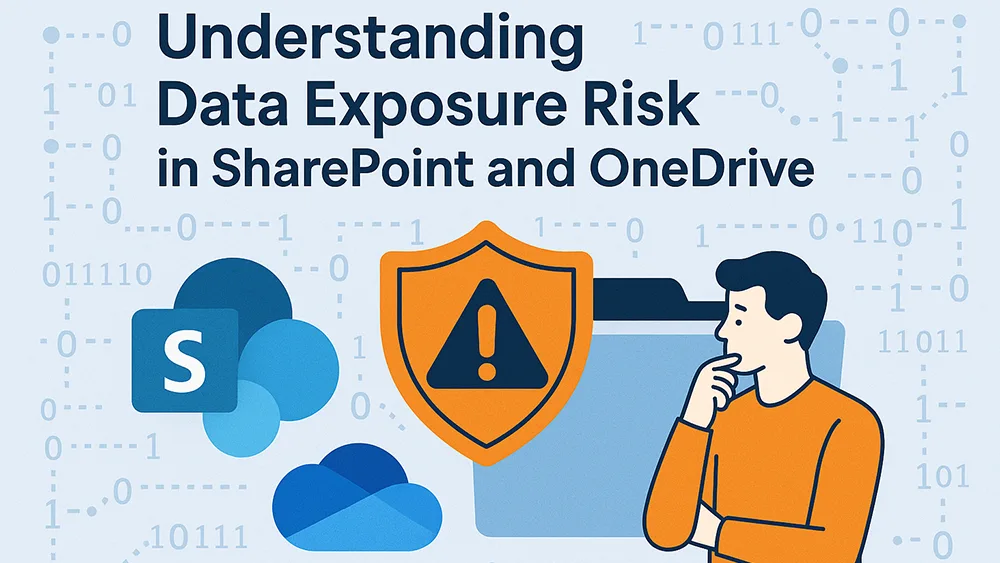What is the difference between SharePoint and OneDrive?

Posted on September 13, 2024 by Chris Nuttall
SharePoint and OneDrive are both used in daily office life, but not everyone may be aware of what makes them different and when is best to use them. In this blog we’ll look at what OneDrive and SharePoint are made for, and the key differences between the two.
What is OneDrive?
OneDrive is a cloud storage solution designed for personal or business use. You can use it to store your files, share them with friends, family or colleagues and work together on documents. OneDrive is designed more for individuals, either for personal use or when working in a business to have a place to store personal files in a backed-up space.
What is SharePoint?
SharePoint is a digital workspace that helps your organisation stay organised by storing and managing documents in one place, enabling team collaboration on projects, and serving as an internal website for company news and information. It also automates routine tasks to save time and ensures data security with the ability to set permissions and access controls at an admin level, leaving organisations in control over who can access what.
What is the difference between OneDrive and SharePoint?
OneDrive is designed for personal use, such as working on files that only you need access to as files are private by default but can be shared when ready.
SharePoint, on the other hand, is a collaborative by nature. As soon as a file is saved in SharePoint, it is accessible by everyone who has access to that site or folder. With SharePoint you can also work live in tools such as Excel, Word and PowerPoint with colleagues without needing to be in the same room.
OneDrive vs SharePoint: a comparison
While they may seem similar at face value, there are some notable differences between the two when you look beyond the fact that they’re both cloud-based storage solutions.
Collaboration
OneDrive for collaboration
OneDrive is designed for personal file storage but can facilitate collaboration once shared with select people.
SharePoint for collaboration
On the other hand, SharePoint is built for collaboration from the offset. Once a file is saved in SharePoint, anyone who has access to the folder can edit and view the device. With SharePoint, you control access at site level rather than at file level, making it easy for organisation wide collaboration as there’s no need to share each file with multiple people and run into version history issues.
Storage
OneDrive storage is managed by account, whereas SharePoint storage is calculated by site (essentially how you group folders and access).
OneDrive storage
OneDrive storage works out as the following:
| Plan | OneDrive Storage Amount |
| Free | 5GB |
| Microsoft 365 Basic | 100GB |
| Microsoft 365 Personal | 1TB |
| Microsoft 365 Family | 1TB |
| Microsoft Enterprise (E3 and E5) | 1TB |
| Office 365 (E1, E3 and E5) | 1TB |
| Microsoft Teams Enterprise | 10GB |
| Microsoft 365 Frontline (F1, F3 and F5) | 2GB |
SharePoint storage
SharePoint is calculated differently, as each site (collection of folders and files) gets 1 Terabyte, before going up by 10GB with every license purchased on most license types:
| Feature | Microsoft 365 Business Basic, Business Standard, Business Premium, Teams Essentials (MSA and Microsoft Entra ID)7 | Microsoft 365 A3, E3, G3 & A5, E5, G5, Office 365 A3, E3, G3 & A5, E5, G5, Office 365 A1, E1, G1, SharePoint Plan 1 or 2, Teams Enterprise, Teams EEA | Microsoft 365 F1 or F3, Office 365 F3 |
| Total storage per organization | 1 TB plus 10 GB per license purchased | 1 TB plus 10 GB per license purchased | 1 TB |
| Max storage per site (site collection) | 25 TB | 25 TB | 25 TB |
| Sites (site collections) per organization | 2 million | 2 million | 2 million |
| Number of licensed users | Up to 300 | 1- 500,000 | 1- 500,000 |
Sharing
Sharing is possible with both OneDrive and SharePoint but each works slightly differently.
Sharing in OneDrive
Sharing in OneDrive is done at file or folder level. You can choose to share files within an organisation, certain people or just keep it private. Either way, you have to share it on a file-by-file basis or with shared folders. Sharing with OneDrive is intentional, meaning that you have to take a positive action for it to happen.
Sharing with SharePoint
As SharePoint is designed for business, to be able to share you need to be part of the organisation or be granted guest privileges to certain folders or files. Admins can set up sharing rules and accesses, ensuring that only those who need to access certain files, do.
Any file saved in SharePoint will be, by default, shared with those that have access to the site and/or folder, so it’s important to only save documents in SharePoint when they are ready for viewing.

Security features
OneDrive security
OneDrive offers the following security features:
- Encryption: OneDrive uses AES 256-bit encryption for data at rest and TLS encryption for data in transit.
- Two-Factor Authentication (2FA): Adds an extra layer of security by requiring a second form of verification.
- Personal Vault: A protected area within OneDrive that requires strong authentication to access.
- Suspicious activity monitoring: Alerts you to any unusual sign-in attempts.
- Virus scanning: Scans files for known threats using Windows Defender.
- Zero standing access: Engineers do not have standing access to the service; access is granted only when necessary and for a limited time.
SharePoint security
SharePoint offers a similar set of features as standard, but there are additional features as it is designed for business:
- Data encryption: Like OneDrive, SharePoint uses AES 256-bit encryption for data at rest and TLS encryption for data in transit.
- Access controls: Role-based access control at various levels (site, list, item) to manage permissions.
- Data Loss Prevention (DLP): Helps prevent sensitive information from being shared inappropriately.
- Multi-Factor Authentication (MFA): Requires multiple forms of verification to access the service.
- Customer lockbox: Allows you to control access to your data by requiring approval for Microsoft engineers to access your content.
- External sharing management: Configurable settings to manage how data is shared externally.
SharePoint vs OneDrive: Which do you need?
Ultimately, SharePoint and OneDrive have two different purposes. SharePoint is designed for you to work with colleagues easily, whereas OneDrive is more about you storing personal files for you to share if needed. As you get both with any business Microsoft license, it’s important that you and your employees understand the distinction between the two and when to use OneDrive versus when to use SharePoint.
Need help getting the most out of SharePoint and OneDrive?
Get in contact with our team today to learn more about how we can help make Microsoft work for you.







